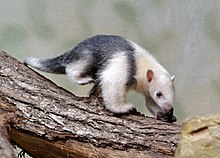Southern tamandua
[citation needed] The oldest fossil tamanduas date from the Pleistocene of South America, although genetic evidence suggests they may have diverged from their closest relative, the giant anteater, in the late Miocene, 12.9 million years ago.[4] The individual and geographic variation observed in the southern tamandua have made the taxonomic description of these animals a difficult task.Animals from northern Brazil and Venezuela to west of the Andes are solid blonde, brown, or black, or are only lightly vested.If it is threatened in a tree it grasps a branch with its hindfeet and tail, leaving its arms and long, curved claws free for combat.[citation needed] This animal has small eyes and poor vision, but its large, upright ears indicate that hearing is an important sense.[10][11] Anteaters extract their prey by using their extremely strong fore limbs to rip open nests and their elongated snouts and rounded tongues (up to 40 cm (16 in) in length) to lick up the insects.[12] Although it has the same diet as the giant anteater, both animals are able to live alongside one another, perhaps because the southern tamandua is able to reach nests in trees, while its larger relative cannot.


Conservation statusLeast ConcernIUCN 3.1Scientific classificationEukaryotaAnimaliaChordataMammaliaPilosaMyrmecophagidaeTamanduaBinomial nameLinnaeusSynonymsspeciesanteaterSouth AmericaTrinidadCaribbeansolitary animaltermitesVenezuelaArgentinaBrazilUruguayrainforestsavannathorn scrubstreamsriversepiphytesPleistocenegenetic evidencegiant anteaterMioceneGeoffroyColombiathe GuianasThomasEcuadorParaguayBoliviaGustav MützelBrehms Tierlebennorthern tamanduapolyestrousGestationarmadillosacanthocephalanGigantorhynchus echinodiscusGigantorhynchus lopezneyraiGigantorhynchus ungriaiarmy antscarpenter antsNasutitermesleafcutter antsbeetlelarvaeWilson, D. E.IUCN Red List of Threatened SpeciesBibcodeEmmons, Louise H.EutheriaXenarthraFolivora (Sloths)BradypodidaeBradypusPygmy three-toed sloth (B. pygmaeus)Maned sloth (B. torquatus)Pale-throated sloth (B. tridactylus)Brown-throated sloth (B. variegatus)CholoepodidaeCholoepusLinnaeus's two-toed sloth (C. didactylus)Hoffmann's two-toed sloth (C. hoffmanni)Vermilingua (Anteaters)CyclopedidaeCyclopesSilky anteater (C. didactylus)MyrmecophagaGiant anteater (M. tridactyla)Northern tamandua (T. mexicana)WikidataWikispeciesARKiveiNaturalistObservation.orgOpen Tree of LifePaleobiology DatabaseZooBank